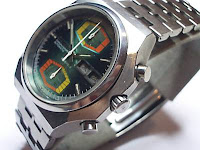
The heading translates as the last six seconds in the countdown for a rocket launch from Baikonur Cosmodrome, USSR.
What on earth (or in space) does that have to do with anything? I hear you ask.
Well, I was a child of the space-age.
When the USSR launched Sputnik in 1957, I was just on 11 years old and from that moment I followed the space-race so keenly that I would lay awake at night in my boarding-school bed listening (on a small transistor radio with ear-piece) to The Voice Of America short-wave broadcasts of every US space launch.
The Russians weren't as forth-coming; they would only publicly announce after the event (and then only if it was successful) but the excitement I felt wasn't any less.
On 12th. April 1961 the first man went into space: Yuri Gagarin orbited the earth.
This was science-fiction come to life and it didn't matter that the hero was Russian - it was the event itself that was awesome.
Anyway - getting to the point - I recently discovered that the type of watch that Gagarin wore into space was available on the internet and, after doing some research, I happened upon the example shown here.
The watch-band and the dial are reproductions - modern replacements for what must have been very tired 50-year old originals - and the original perspex crystal has been replaced with a more recent (acrylic) item, but the movement, case and back-plate are exactly as issued back in the 1960's.

It was a hand-wound Shturmanskie (often spelt without the 'h') with central seconds complication and a hacking feature that allowed the watch to be precisely stopped and synchronised with a given time signal.
What on earth (or in space) does that have to do with anything? I hear you ask.
Well, I was a child of the space-age.
When the USSR launched Sputnik in 1957, I was just on 11 years old and from that moment I followed the space-race so keenly that I would lay awake at night in my boarding-school bed listening (on a small transistor radio with ear-piece) to The Voice Of America short-wave broadcasts of every US space launch.
The Russians weren't as forth-coming; they would only publicly announce after the event (and then only if it was successful) but the excitement I felt wasn't any less.
On 12th. April 1961 the first man went into space: Yuri Gagarin orbited the earth.
This was science-fiction come to life and it didn't matter that the hero was Russian - it was the event itself that was awesome.
Anyway - getting to the point - I recently discovered that the type of watch that Gagarin wore into space was available on the internet and, after doing some research, I happened upon the example shown here.
The watch-band and the dial are reproductions - modern replacements for what must have been very tired 50-year old originals - and the original perspex crystal has been replaced with a more recent (acrylic) item, but the movement, case and back-plate are exactly as issued back in the 1960's.

It was a hand-wound Shturmanskie (often spelt without the 'h') with central seconds complication and a hacking feature that allowed the watch to be precisely stopped and synchronised with a given time signal.
The Shturmanskie that Gagarin wore into space had a highly finished (including Geneva striping) 17 jewel, shock protected movement. The movement was housed in a chrome plated, two-piece case measuring 33 mm across, 12 mm high, with a 16 mm lug size and had a stainless steel screw back.
A little item of nostalgia with which to commemorate the 48th. anniversary of the event and something which I will enjoy wearing occasionally.








































